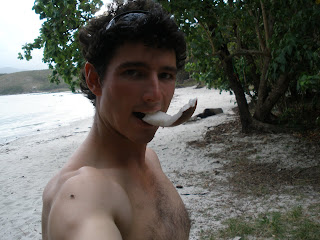My 4 months involved a heap of diving on the Great Barrier Reef, working on the coral trout boat Irene, plenty of partying in Cairns, a few trips to the Tablelands, a few weeks at home for xmas, two weeks at home for RYLA (Rotary Youth Leadership Awards camp), 10 days in Sydney at New Year, and a 4,500 km road trip around the northern half of QLD. All of which was awesome fun!
Now I am back on the road. On the 3rd leg of my journey. I have done North, I have been East, now I am headed South!
I have been through the Tully/Innisfail/Mission Beach area a few times since I have been in Nth QLD, and it is a nice area of rainforest, sugarcane, bananas, and the occasional Cassowary. But after cyclone Yasi hit the area a month ago it is a different story. First things first, yes Yasi was a disaster, but thankfully there was no loss of life . For a massive Cat 5 cyclone that was meant to be the strongest in living memory the damage to the human environment is pretty tame a month on. Yes sheds are blown over there are big potholes in roads, the power infrastructure has taken some repairing, some building have had tin ripped off, and the occasional one no longer exist. This damage will be costly to repair, but is nothing like what has occurred as a result of the Christchurch or Japanese earthquakes. Clearly we have become pretty reasonable at dealing with cyclones.
Natures building code on the other hand is not so resilient. The place really does look like a disaster zone, in places apart from a few new shoots, vines clinging to trunks, and a bit of undergrowth the forest looks like it has been through a pyroclastic flow event. Every bit of forest in the winds path has a heap of trees down, more snapped off a fair way up the trunk, and lots consisting of a trunk and a few major branching arms snapped a couple of metres along. The universal theme is no leaves. There are a few starting to reshoot, and there are a heap on the ground, but not many that survived the wind! It will take it a while to get back to proper rainforest, and in the mean time hopefully the wildlife will mostly survive.
In terms of the agriculture yes there are plenty of bananas on the ground but cyclones don't actually kill the plants, the tallest suckers fall over and lose their fruit but the younger ones are protected and are bouncing away so the fruit will not be too far away, though there are heaps of mature suckers that need to be cut down. On the sugar front, all the cane was blown over at a fair angle, but it has bent itself back up. There will still be a fair bit of cane there - it may be a little more difficult to harvest though. The real impact on sugarcane farmers will probably be from the wet and lack of sunshine - plants need sun to grow and cane likes plenty of it, but instead it just keeps on raining and raining...
 Bananas on the ground near Tully
Bananas on the ground near Tully A good example of the destruction of the forest near Innisfail
A good example of the destruction of the forest near Innisfail




 A (ex)timber planatation near Innisfail
A (ex)timber planatation near Innisfail

















